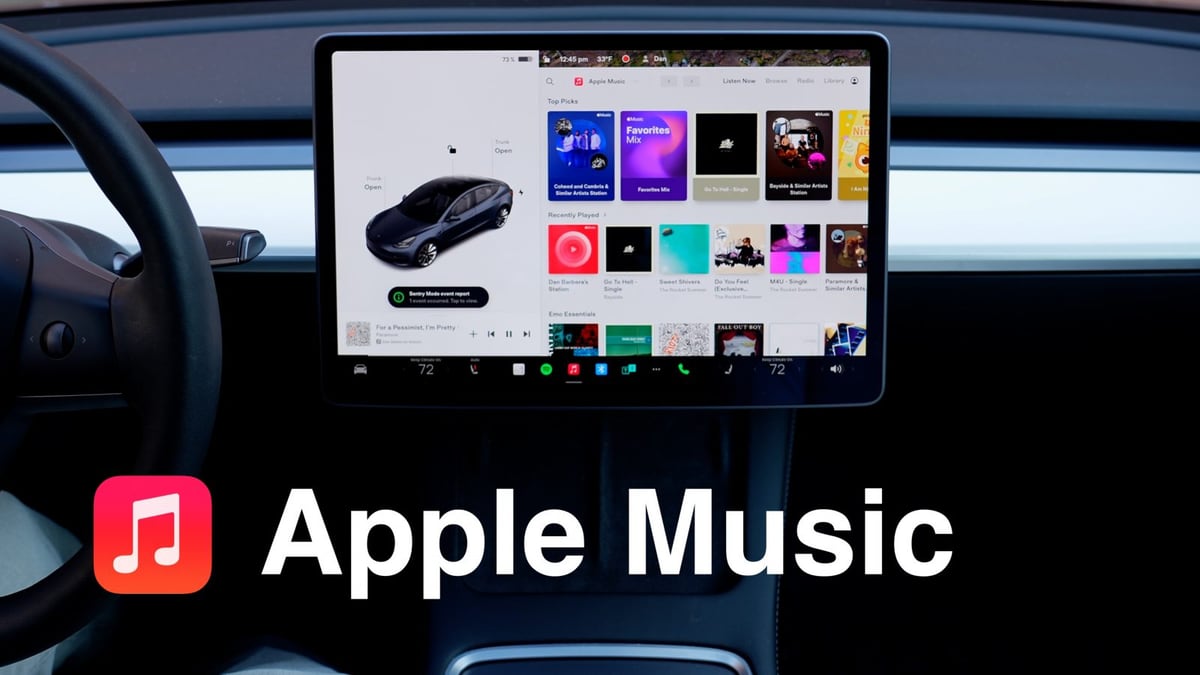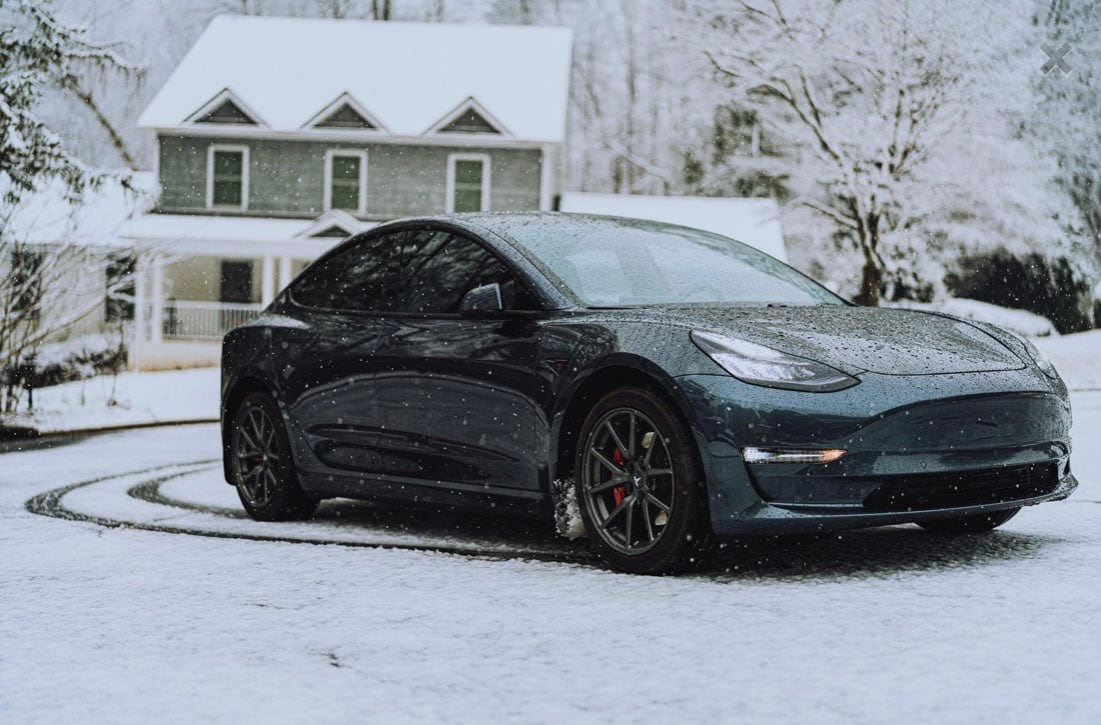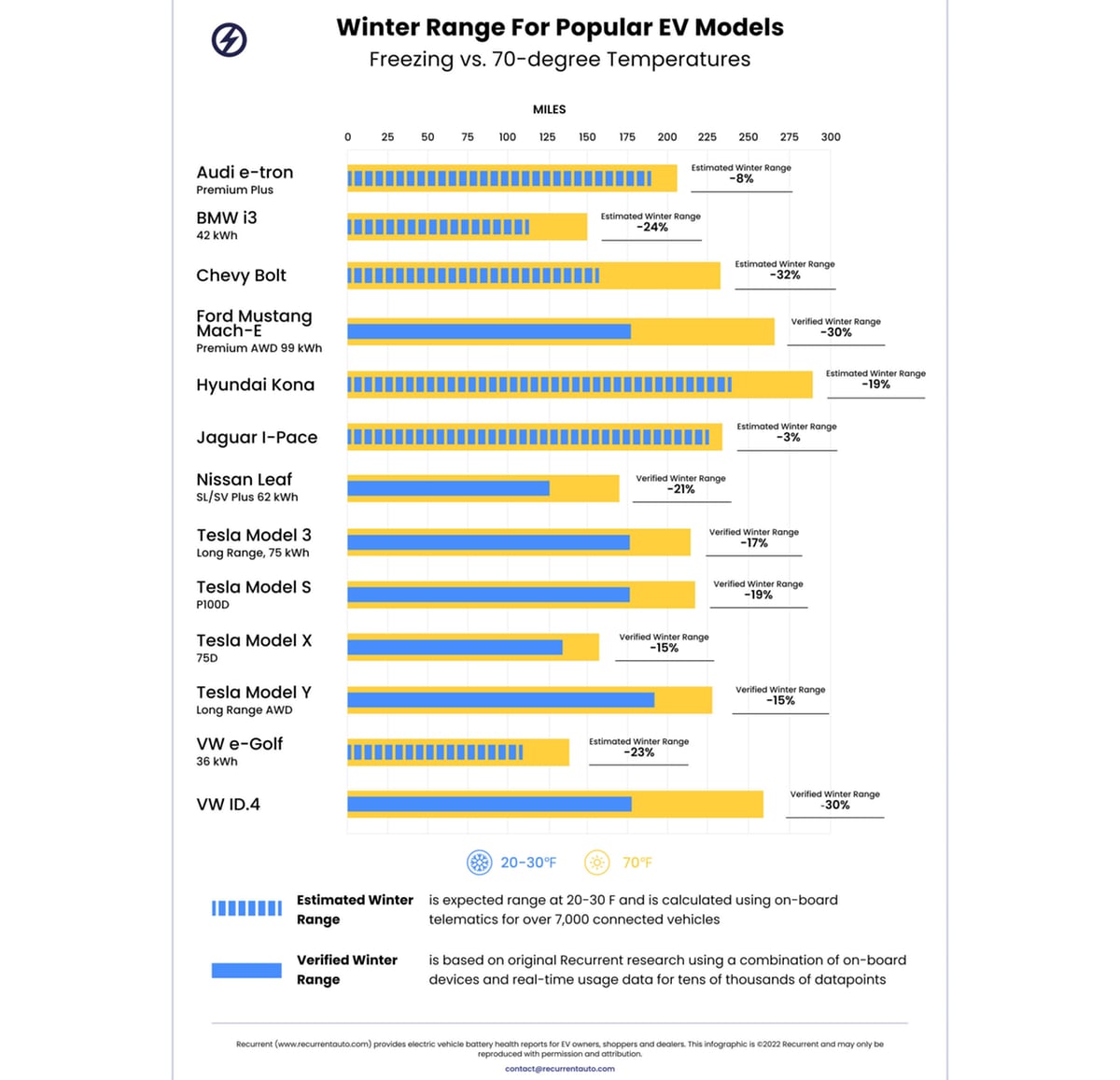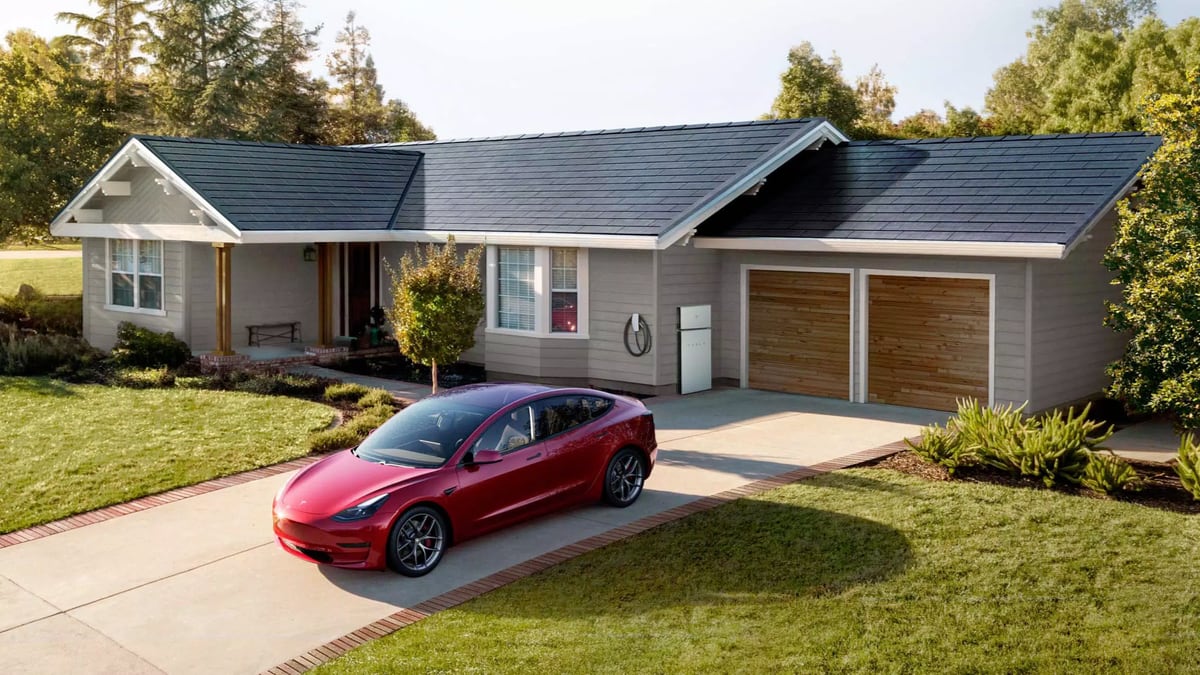By Lennon Cihak

Apple Music may be available in Tesla’s new holiday update, but don’t expect the lossless audio quality that Apple Music subscribers enjoy… at least not yet.
Tesla owner and software developer Dan Burkland recently performed some tests on the audio quality that Tesla’s in-car streaming services TIDAL, Spotify, and now Apple Music stream at in the vehicle.
Burkland tested TIDAL previously on a different Tesla software version, but with Tesla’s ever-changing software and the rollout of the holiday update he chose to run the tests again.
Setup and Songs Used to Test
He connected his Model Y to his home’s WiFi network and used a DHCP reservation, which allowed him to have the vehicle use a specific IP address. He then installed ntopng on his OPNsense firewall to monitor traffic statistics for the vehicle. After zeroing out the host stats for the Model Y, he tested a total of nine songs, including “Purple Rain” by Prince, “Foreplay” by Boston, and “Kashmir” by Led Zeppelin.
Results
The results of Burkland’s tests concluded that TIDAL still offers the best listening experience. The average bitrate for TIDAL was ~1165 kbps. This isn’t entirely too shocking, as TIDAL has always championed the highest-quality audio streaming experience.
Surprisingly, Spotify’s audio quality came in ahead of Apple Music to nab second place. Burkland’s tests showed Spotify streaming at an average bitrate of ~157 kbps, while Apple Music came in at a subpar ~118 kbps.
Burkland added that he believes Apple Music is limiting bitrate for the in-car app, but a future update to Tesla’s software will hopefully resolve this. If Tesla can enable lossless streaming for Apple Music, it’ll give TIDAL a run for its money in high-fidelity streaming via the in-car app.
Check out some of Dan’s test results below, or for a complete list view his Reddit thread.
| So Many Tears by 2Pac | Young Lust by Pink Floyd | Dancing In The Dark by Bruce Springsteen | |
| Length (MM:SS) | 3:59 | 3:30 | 4:05 |
| Length (Seconds) | 239 | 210 | 245 |
| Est. Data Transfer @ 96 Kbps (MB) | 2.80 | 2.46 | 2.87 |
| Est. Data Transfer @ 128 Kbps (MB) | 3.73 | 3.28 | 3.83 |
| Est. Data Transfer @ 160 Kbps (MB) | 4.67 | 4.1 | 4.79 |
| Est. Data Transfer @ 192 Kbps (MB) | 5.60 | 4.92 | 5.74 |
| Est. Data Transfer @ 256 Kbps (MB) | 7.47 | 6.56 | 7.66 |
| Est. Data Transfer @ 320 Kbps (MB) | 9.34 | 8.2 | 9.57 |
| Est. Data Transfer @ 1411 Kbps (MB) | 41.17 | 36.17 | 42.2 |
| Apple Music (MB) | 4.10 | 3.20 | 4.80 |
| Apple Music (Bitrate – Kbps) | 140.53 | 124.83 | 160.50 |
| Spotify (MB) | 6.70 | 5.80 | 2.90 |
| Spotify (Bitrate – Kbps) | 229.65 | 226.26 | 96.97 |
| Tidal (MB) | 27.40 | 21.50 | 30.50 |
| Tidal (Bitrate – Kbps) | 939.17 | 838.70 | 1019.82 |
Other Tesla Owners Are Running Similar Tests
Reddit user u/OverlyOptimisticNerd ran similar tests with a slightly different configuration. They used an iPhone 14 as a mobile hotspot, Hotspot Monitor Data Usage from Apple’s App Store, and 2019 Model 3 running version 2022.44.25.1.
During their tests, they observed the same pattern across all songs, citing that a bunch of data rolled in at the beginning of the tests and then slowly trickled through. The low data rate for Apple Music appears to align with the company’s HE-AAC codec at 64 kbps.
“It appears to buffer most or even all of the song, then pause between tracks to do it again,” writes u/OverlyOptimisticNerd. “On average, I saw ~2MB per track, with ~1.7MB during the initial burst and ~0.3MB throughout the track. This is consistent with the HE-AAC standard, as most of these songs were a little over 3 minutes in length.”
While Apple Music may come in at the lowest average bitrate of all three services tested, it’s important to note that it doesn’t necessarily mean it has the lowest quality. Audio quality comes down to a variety of factors, some of which are the bitrate used, whether it’s variable and the codec efficiency.
Apple Music’s HE-ACC codec is optimized for low-bandwidth applications meaning that it can outperform an ACC-encoded file in lower-bandwidth situations. In the real-world Apple Music in your Tesla should sound very similar to streaming music from Spotify, but not as good as TIDAL’s offerings.
By Lennon Cihak

Teslas are among the most efficient electric vehicles in cold weather, according to a Recurrent study.
Cold weather often affects the range of electric vehicles due to two reasons. The colder weather alters the battery’s chemistry slightly; therefore, the range is decreased. The decreased range could mean some owners may have to modify their trips in the winter months when compared to warmer seasons.
Electric Vehicle Heaters
However, the biggest contributor to the decreased range for electric vehicles is due to heat production. Since electric vehicles are much more efficient than their internal combustion counterparts, they produce very little excess heat. Whereas heat is a byproduct of gasoline engines and can be funneled into the cabin to heat the passengers, electric vehicles need to produce additional heat to keep their passengers comfortable.
Resistive Heaters
This is typically done in two ways, either through electric resistance heating or through a heat pump. A resistive heater is like a space heater you may use at home. Electric current passes through wires causing them to heat up and the heat is then blown into the room.
Heat Pumps
Heat pumps are more complicated and work much differently than resistive heaters, however, they’re also more efficient in most cases. They work by using outside air to warm up a refrigerant that is then pressurized to increase the temperature of the refrigerant. The refrigerant then flows to the inside of the cabin where the vehicle air passes through it, causing it to warm up and flow into the cabin. While heat pumps are much more efficient when compared to electric heaters, that efficiency is reduced the colder it is outside.
Which Teslas Have Heat Pumps
All newer Teslas use heat pumps instead of resistive heaters due to their increased efficiency. All redesigned Model S and Model X vehicles use heat pumps, as well as all Model Ys. However, some Model 3 vehicles between 2017-2020 use resistive heaters to warm the cabin, which makes them less efficient in colder months.
Find Out Your Type of Heater
If you don’t know whether your Tesla has a heat pump or a resistive heater, you can find out by simply looking at your car’s software. Your vehicle’s heater type will be listed if you navigate to Controls > Software and then tap on Additional Vehicle Information.
Due to Tesla’s unique heating system and its efficiencies, Recurrent found that Tesla vehicles hold some of the best range among electric cars. So, Tesla owners may not have to make as many modifications to their commutes. They’re able to manage this because of their state-of-the-art battery technology, as well as using localized heating through heated seats, steering wheel, and cabin, as well as their advanced heat pumps.

A new study published by Recurrent pulled data from 7,000 electric vehicles from the 14 most popular brands, including Audi, BMW, Hyundai, and Tesla. The data for each vehicle was gathered via the onboard telemetry and real-time usage. The vehicles were used in freezing (20-30 degrees F) temperatures and warm 70° F. As temperatures drop below 50° F, heat pumps start becoming less efficient.
Recurrent’s findings concluded that Tesla’s Long Range AWD Model Y and Model X 75D lost 15%, while the Long Range Model 3 with 75kWh battery lost 17%, and Model S P100D lost 19%. Compared to the Chevy Bolt, which lost 32%, and Ford’s Mustang Mach-E, which lost 30%, Tesla’s vehicles appear to be better equipped for cold weather. Unfortunately, Recurrent tested older Teslas that did not contain heat pumps, which means that Teslas numbers would have been even better if Recurrent used newer models. Even so, Tesla had some of the best performing vehicles.
Comparing Heat Pumps vs Resistive Heaters in Teslas
As Tesla continues to make improvements to its vehicles, their battery supplier, CATL, recently announced they’ve produced a battery that offers 430 miles of range.
By Gabe Rodriguez Morrison

After gaining experience through its virtual power plants (VPPs), Tesla has launched “Tesla Electric” to become an electricity retailer through its Powerwall infrastructure.
Tesla’s virtual power plant is a connection of distributed energy storage systems that work in tandem to give energy back to the grid to avoid dirty and costly peak power plants, which helps stablize the grid. Essentially, when the grid is being strained, Tesla’s VPP can kick in and draw power from Powerwall owners enrolled in the program helping avoid brownouts and earning Tesla owners some extra cash.
Tesla Electric, however, differs from Tesla’s VPP in that its goal is to manage excess electricity. Tesla Electric is an electric power plan for Powerwall owners, starting with owners residing in Texas. With Tesla Electric, the Powerwall will automatically decide when to use electricity and when to sell electricity back to the grid, maximizing profits for owners.
The service brings Tesla’s expertise in energy markets and energy storage to your home, maximizing the value of your solar energy while using your Powerwall storage to add more renewable electricity to the grid.
Tesla Electric unlocks more value from energy you send to the grid using algorithms that monitor electricity prices in your area and direct your Powerwall to sell energy when prices are highest.
Unlike other solar buyback plans, where excess solar is ‘bought’ when it is abundant and cheap, Tesla Electric enables customers to sell energy when it is in higher demand and more valuable.
Solar and Powerwall can help you and your community accelerate the transition to sustainable energy. When importing electricity from the grid, Tesla Electric offsets your usage with energy from 100 percent renewable sources.
“Together with other Tesla Electric members, you can maximize the value of your solar energy while using your Powerwall storage to add more renewable electricity to the grid.”
Tesla Electric is currently only available in Texas, with Tesla looking to support additional states in the future. To be eligible, you need to have Tesla solar and at least one Powerwall and live in an area of Texas that offers retail choice.






